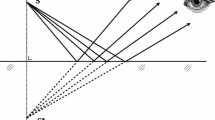Abstract
Students' conceptions of how objects are seen directly, and in mirrors, were explored in an analysis of their written and drawn responses to common visual phenomena depicted in cartoons with brief text. Students in Grades K-10 (n=214) completed a questionnaire and some were interviewed. Evidence was sought to support an hypothesis for increasingly sophisticated responses related to the concepts of sight, light, reflection and image. The developmental model used in this analysis was the updated SOLO Taxonomy (Biggs & Collis, 1991; Collis & Biggs 1991). It appears from the results that different modes of functioning can interfere to produce factually incorrect recollections of experience particularly in the age group 7 to 13 years approximately. Also, this is associated with the common spurious conception that mirrors have a lateral inversion property. Explanations involving light were extremely rare and its role related to the production of an image ‘in the mirror’ but not to the perception of an image in the eyes.
Similar content being viewed by others
References
Adams, R.J. Doig, B.A. & Rosier, M. (1990).Science learning in Victorian schools: 1990. ACER Research Monograph No. 41, Melbourne: ACER.
Andersson, B. & Kärrquist, C. (1983). How Swedish pupils, aged 12–15 years, understand light and its properties.European Journal of Science Education.5, 387–402.
Biggs, J.B. & Collis, K.F. (1982).Evaluating the quality of learning: The SOLO taxonomy. New York: Academic Press.
Biggs, J.B. & Collis, K.F. (1991). Multimodal learning and the quality of intelligent behaviour. In H. Rowe (Ed.),Intelligence: Reconceptualisation and measurement. Hillsdale NJ: Laurence Erlbaum.
Collis, K.F. & Biggs, J.B. (1991). Developmental determinants of qualitative aspects of school learning. In G. Evans (Ed.),Learning and teaching cognitive skills. Melbourne: ACER
Guesne, E. (1985). Light. In R. Driver, E. Guesne & A. Tiberghien (Eds.),Children's ideas in science. Milton Keynes, UK: Open University Press.
Jones, B.L., Collis, K.F. & Watson, J.M. (1993). Towards a theoretical basis for students' alternative frameworks in science and for science teaching.Research in Science Education, 23, 126–135
Pfundt, H. & Duit, R. (1991).Bibliography of students' alternative frameworks in science (3rd ed.), Kiel, Germany: Institute for Science Education, University of Kiel.
Stead, B.F. & Osborne, R.J. (1980). Exploring science students' concepts of light.Australian Science Teachers' Journal, 26(3), 84–90.
Strauss, S. (1982)U-shaped behavioural growth. New York: Academic Press.
Author information
Authors and Affiliations
Additional information
Specializations: science education, students' understandings of phenomena in science.
Specializations: cognitive development, evaluation, mathematics and science education.
Specializations: mathematics education, students' understanding of chance and data concepts.
Rights and permissions
About this article
Cite this article
Jones, B., Collis, K., Watson, J. et al. Images in mirrors: Recollections, alternative explanations and modes of cognitive functioning. Research in Science Education 24, 191–200 (1994). https://doi.org/10.1007/BF02356344
Issue Date:
DOI: https://doi.org/10.1007/BF02356344




